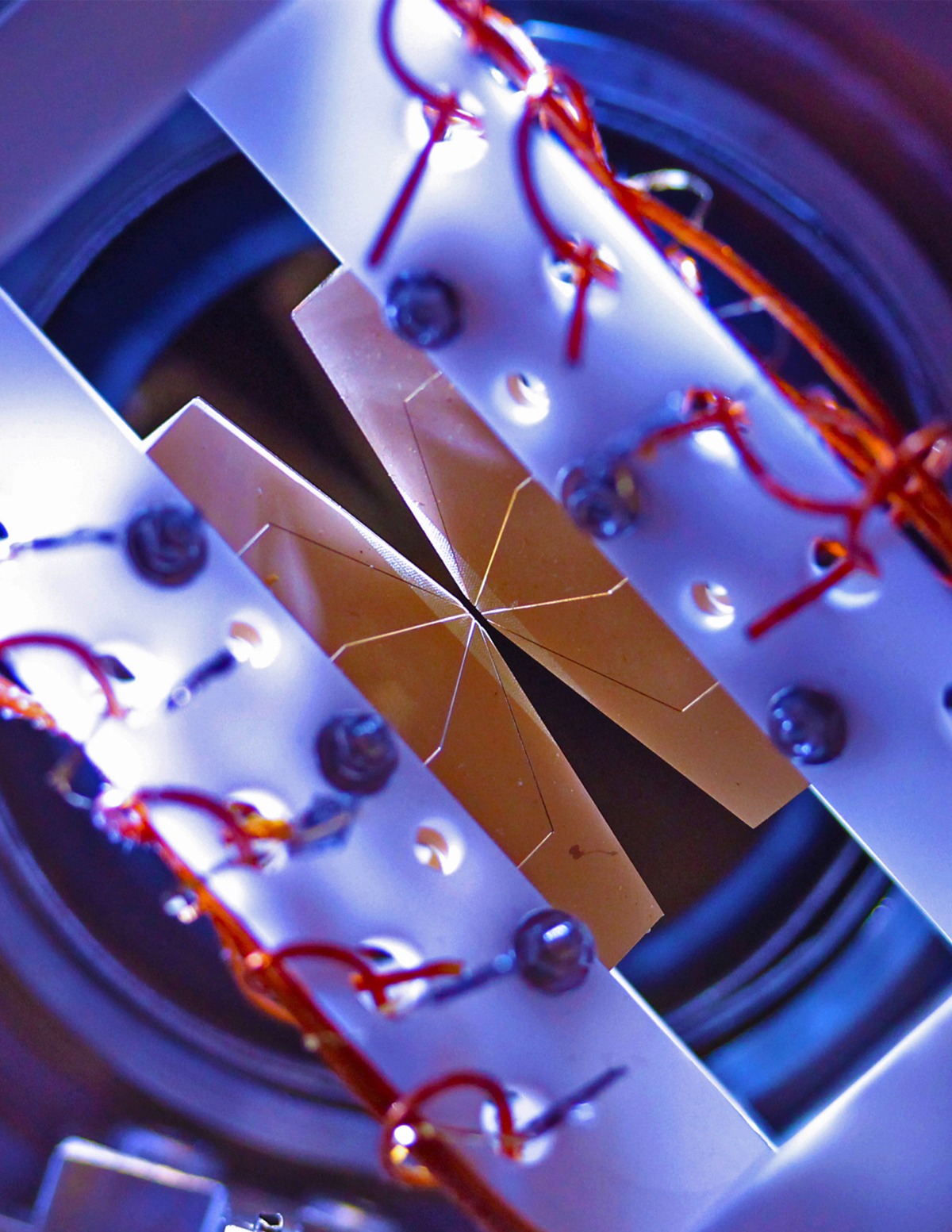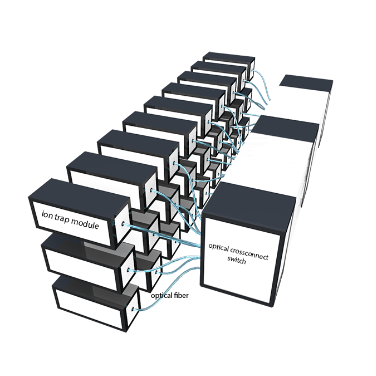

JQI researchers, under the direction of Christopher Monroe have demonstrated modular entanglement between two atomic systems, separated by one meter. Here, photons are the long distance information carriers entangling multiple qubit modules. Inside of a single module, quantized collective vibrations called phonons connect individual qubits. In the latest result, one module contains two qubits and a second module houses a single qubit. This work was published in the journal Nature Physics, along with two related results that appeared in the Physical Review journals.
The two-by-one qubit entanglement is an experimental result that follows the theoretical design by Monroe and collaborators on building a modular universal quantum computer, published in early 2014. This group is pursuing a modular quantum computer architecture that promises scalability to much larger numbers of qubits. The components of this architecture have individually been tested and are available, making it a practical approach. Previously, the authors presented expected performance and scaling calculations, demonstrating that their architecture is not only viable, but in some ways, preferable when compared to related schemes.
How do you build a universal quantum computer? Turns out, this question was addressed by theoretical physicists about 15 years ago. The answer was laid out in a research paper and has become known as the DiVincenzo criteria.
The prescription is pretty clear at a glance; yet in practice the physical implementation of a full-scale universal quantum computer remains an extraordinary challenge.
Qubits, like all quantum systems, can become “entangled,” or correlated in ways that are impossible in conventional devices. A quantum computing device must create and maintain these quantum connections in order to have a speed and storage advantage over any conventional computer. Harnessing entanglement for computation only works when the qubits are almost completely isolated from the outside world. Isolation and control becomes much more difficult as more and more qubits are added into the computer.
Basically, as quantum systems are made bigger, they generally lose their quantum-ness.
One leading platform the pursuit of a quantum computer is trapped atomic ions, where nearly 20 qubits have been juxtaposed in a single quantum register. However, scaling this or any other type of qubit to much larger numbers while still contained in a single register will become increasingly difficult, as the connections will become too numerous to be reliable.
Individual qubit modules are at the computational center of Monroe's design, each one consisting of a small crystal of perhaps 10-100 trapped ions confined with electromagnetic fields. In the latest result, two modules are connected, one having two qubits, and the other having a single qubit. The qubits are stored in each atomic ion’s internal energy levels. Within a single module, logic gates performed and two (or more) ions can be entangled using the ions' collective properties. This module is entangled via photons to a second module that contains a single qubit. The switch, a technology developed in the telecommunications industry, is not yet implemented in the most recent experimental demonstration, but is critical for scaling to more qubits and more modules


Modularity is a common property of complex systems, from social networks to biological function, and will likely be a necessary component of any future large-scale quantum computer.
Monroe explains, "This is the only way to imagine scaling to larger quantum systems, by building them in smaller standard units and hooking them together. In this case, we know how to engineer every aspect of the architecture."

In conventional computers, modularity is routinely exploited to realize the massive interconnects required in semiconductor devices, which themselves have been successfully miniaturized and integrated with other electronics and photonics. The first programmable computers were the size of large rooms and used vacuum tubes, and now people have an incredible computer literally at their fingertips. Today’s processors have billions of semiconductor transistors fabricated on chips that are only about a centimeter across.
Similar fabrication techniques are now used to construct computer chip-style ion-traps, sometimes with integrated optics. The modular quantum architecture proposed in this research would not only allow many ion-trap chips to be tied together, but could also be exploited with alternative qubit modules that couple easily to photons such as qubits made from nitrogen vacancy centers in diamond or ultracold atomic gases (the neutral cousin of ion-traps).
